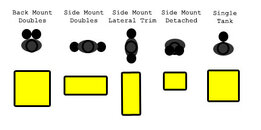calling it a cute trick and implying it's inherently dangerous is unfair and very biased.
I agree with this. A skill/drill is only as good as the learning that developed it. Proper training is (should be) given on both techniques; feather-breathing and reg swapping.
Otherwise, if assuming no skill-set behind a drill, it'd be easy to level the same cynicism at valve or manifold shut-downs etc, ... cute tricks... but what happens when you rely on them? We all know the answer - if properly trained and rehearsed, they are no problem whatsoever.
So, that brings us to 'proper training'. If feathering is to be selected as a contingency skill, then it needs to be trained properly. That means extensive practice - in real situtions. The same way you'd practice any other technical/overhead skill. Gain skill familiarization in controlled circumstances, develop muscle memory from repetition, then apply under realistic conditions. It's quite feasible to ask a student to complete all, or a majority, of a dive using feather breathing on one of their cylinders. That'll
prove the skill. Skills should be '
proven' before they are adopted and relied upon by the individual.
The same applies to reg-swapping. It's a formal skill for some agencies sidemount courses. The issue of o-ring displacement/loss is covered (
even in the PADI 'Tec Sidemount course). It's not something that's been forgotten.
Anyway, you have two o-rings; one from each reg swapped. A wise diver might have a couple of spare too...just in case.
So, let's consider the reality of reg-swapping;
1) A last ditch drill - only for catastrophic regulator failure, where feather breathing is unsuccessful and gas loss/use from the other cylinder (and team) has exceeded your gas management planning parameters. i.e. very, very rare.
2) First resort is to air-share from team when conducting the swap. No holding breath and rushing.
3) Second resort is to swap from a 3rd cylinder, (stage/deco) if available. Again, no holding breath and rushing.
4) Last resort is to swap directly, one regulator to another, with only 2 cylinders available and no team gas-sharing. This encompasses a very unlikely series of profound diver/team errors and equipment failures. It is very unlikely. Even then, practice and repetition make it achievable. The diver has gas and time prior to the swap (
it isn't an immediate and time-critical action), so they can prepare themselves, their equipment and ensure optimal circumstances to conduct the swap.
As mentioned, I teach this on the PADI Tec Sidemount course, it's a performance standard (
albeit in controlled circumstances). I get AOW/rescue divers sometimes for that training; and they don't seem to have a problem with it. So, I'm somewhat perplexed why Über-experienced cave divers should find it so demanding???






